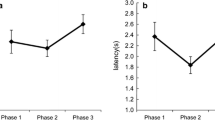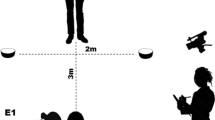Abstract
Several articles have been recently published on dogs’ (Canis familiaris) performance in two-way object choice experiments in which subjects had to find hidden food by utilizing human pointing. The interpretation of results has led to a vivid theoretical debate about the cognitive background of human gestural signal understanding in dogs, despite the fact that many important details of the testing method have not yet been standardized. We report three experiments that aim to reveal how some procedural differences influence adult companion dogs’ performance in these tests. Utilizing a large sample in Experiment 1, we provide evidence that neither the keeping conditions (garden/house) nor the location of the testing (outdoor/indoor) affect a dogs’ performance. In Experiment 2, we compare dogs’ performance using three different types of pointing gestures. Dogs’ performance varied between momentary distal and momentary cross-pointing but “low” and “high” performer dogs chose uniformly better than chance level if they responded to sustained pointing gestures with reinforcement (food reward and a clicking sound; “clicker pointing”). In Experiment 3, we show that single features of the aforementioned “clicker pointing” method can slightly improve dogs’ success rate if they were added one by one to the momentary distal pointing method. These results provide evidence that although companion dogs show a robust performance at different testing locations regardless of their keeping conditions, the exact execution of the human gesture and additional reinforcement techniques have substantial effect on the outcomes. Consequently, researchers should standardize their methodology before engaging in debates on the comparative aspects of socio-cognitive skills because the procedures they utilize may differ in sensitivity for detecting differences.




Similar content being viewed by others
Notes
In the case of Experiment 2, the authors did their best efforts to replicate faithfully the pointing procedure used by Udell et al. (2008a). However, possible minor discrepancies between the two methods were unfortunately impossible to avoid because there was no video material recorded of the original tests of Udell et al. (2008a). The authors are grateful for the kind and professional help from Monique Udell, who assessed the video footage of the testing process and the method section of this paper. Although personal communication between M. U. and the authors of the present article confirmed that there were some discrepancies between the two methodologies, in the opinion of the authors, the present paper can be regarded as a replication of the corresponding experiment of Udell et al. (2008a).
References
Anderson JR, Sallaberry P, Barbier H (1995) Use of experimenter given cues during object-choice tasks by capuchin monkeys. Anim Behav 49:201–208
Gácsi M, McGreevy P, Kara E, Miklósi Á (2009a) Effects of selection for cooperation and attention in dogs. Behav Brain Funct 5:31. doi:10.1186/1744-9081-5-31
Gácsi M, Győri B, Virányi Zs, Kubinyi E, Range F, Belényi B, Miklósi Á (2009b) Explaining dog wolf differences in utilizing human pointing gestures: selection for synergistic shifts in the development of some social skills. PLoS One 4:e6584
Gácsi M, Kara E, Belényi B, Topál J, Miklósi Á (2009c) The effect of development and individual differences in pointing comprehension of dogs. Anim Cogn 12:471–479
Hare B, Brown M, Williamson C, Tomasello M (2002) The domestication of social cognition in dogs. Science 298:1634–1636
Hare B, Rosati A, Kaminski J, Brauer J, Call J, Tomasello M (2010) The domestication hypothesis for dogs’ skills with human communication: a response to Udell et al. (2008) and Wynne et al. (2008). Anim Behav 79:E1–E6
Helton WS, Helton ND (2010) Physical size matters in the domestic dog’s (Canis lupus familiaris) ability to use human pointing cues. Behav Process 85:77–79
Herman LM, Abichandani SL, Elhajj AN, Herman EYK, Sanchez JL, Pack AA (1999) Dolphins (Tursiops truncatus) comprehend the referential character of the human pointing gesture. J Comp Psychol 113:347–364
Kaminski J, Riedel J, Call J, Tomasello M (2005) Domestic goats, Capra hircus, follow gaze direction and use social cues in an object choice task. Anim Behav 69:11–18
Lakatos G, Soproni K, Dóka A, Miklósi Á (2009) A comparative approach to dogs’ (Canis familiaris) and human infants’ comprehension of various forms of pointing gestures. Anim Cogn 12:621–631
Miklósi Á, Soproni K (2006) A comparative analysis of animals’ understanding of the human pointing gesture. Anim Cogn 9:81–93
Miklósi Á, Topál J (2011) On the hunt for the gene of perspective taking: pitfalls in methodology. Learn Behav. doi:10.3758/s1340-011-0038-2
Miklósi Á, Kubinyi E, Topál J, Gácsi M, Virányi Zs, Csányi V (2003) A simple reason for a big difference: wolves do not look back at humans but dogs do. Curr Biol 13:763–766
Miklósi Á, Topál J, Csányi V (2004) Comparative social cognition: what can dogs teach us? Anim Behav 67:995–1004
Miklósi Á, Pongrácz P, Lakatos G, Topál J, Csányi V (2005) A comparative study of the use of visual communicative signals in dog-human and cat-human interactions. J Comp Psychol 119:179–186
Mulcahy N, Call J (2009) The performance of bonobos (Pan paniscus), chimpanzees (Pan troglodytes) and orangutans (Pongo pygmaeus) in two versions of an object choice task. J Comp Psychol 123:304–309
Reid PJ (2009) Adapting to the human world: dogs’ responsiveness to our social cues. Behav Proc 80:325–333
Riedel J, Schumann K, Kaminski J, Call J, Tomasello M (2008) The early ontogeny of human-dog communication. Anim Behav 75:1003–1014
Soproni K, Miklósi Á, Topál J, Csányi V (2002) Dogs’ (Canis familiaris) responsiveness to human pointing gestures. J Comp Psychol 116:27–34
Udell MAR, Dorey NR, Wynne CDL (2008a) Wolves outperform dogs in following human social cues. Anim Behav 76:1767–1773
Udell MAR, Giglio RF, Wynne CDL (2008b) Domestic dogs (Canis familiaris) use human gestures but not nonhuman tokens to find hidden food. J Comp Psychol 122:84–93
Udell MAR, Dorey NR, Wynne CDL (2010a) The performance of stray dogs (Canis familiaris) living in a shelter on human-guided object-choice tasks. Anim Behav 79:717–725
Udell MAR, Dorey NR, Wynne CDL (2010b) What did domestication do to dogs? A new account of dogs’ sensitivity to human actions. Biol Rev 85:327–345
Virányi Zs, Gácsi M, Kubinyi E, Topál J, Belényi B, Ujfalussy D, Miklósi Á (2008) Comprehension of human pointing gestures in young human-reared wolves (Canis lupus) and dogs (Canis familiaris). Anim Cogn 11:373–387
Wobber V, Hare B, Koler-Matznick J, Wrangham R, Tomasello M (2010) Breed differences in domestic dogs’ (Canis familiaris) comprehension of human communicative signals. Interact Stud 10:206–224
Acknowledgments
This paper was supported by the János Bolyai Research Scholarship from the Hungarian Academy of Sciences, and it was also funded by the grants from the European Union FP7-ICT-2007 LIREC 215554, the ETOCOM project (TÁMOP-4.2.2-08/1/KMR-2008-0007) through the Hungarian National Development Agency in the framework of the Social Renewal Operative Programme supported by the EU and co-financed by the European Social Fund and the Hungarian Ministry of Education OTKA K82020. The authors are grateful to Celeste R. Pongrácz for correcting the English language of the manuscript.Footnote 1
Conflict of interest
The authors also declare that they have no conflict of interest.
Author information
Authors and Affiliations
Corresponding author
Appendix
Rights and permissions
About this article
Cite this article
Pongrácz, P., Gácsi, M., Hegedüs, D. et al. Test sensitivity is important for detecting variability in pointing comprehension in canines. Anim Cogn 16, 721–735 (2013). https://doi.org/10.1007/s10071-013-0607-1
Received:
Revised:
Accepted:
Published:
Issue Date:
DOI: https://doi.org/10.1007/s10071-013-0607-1




